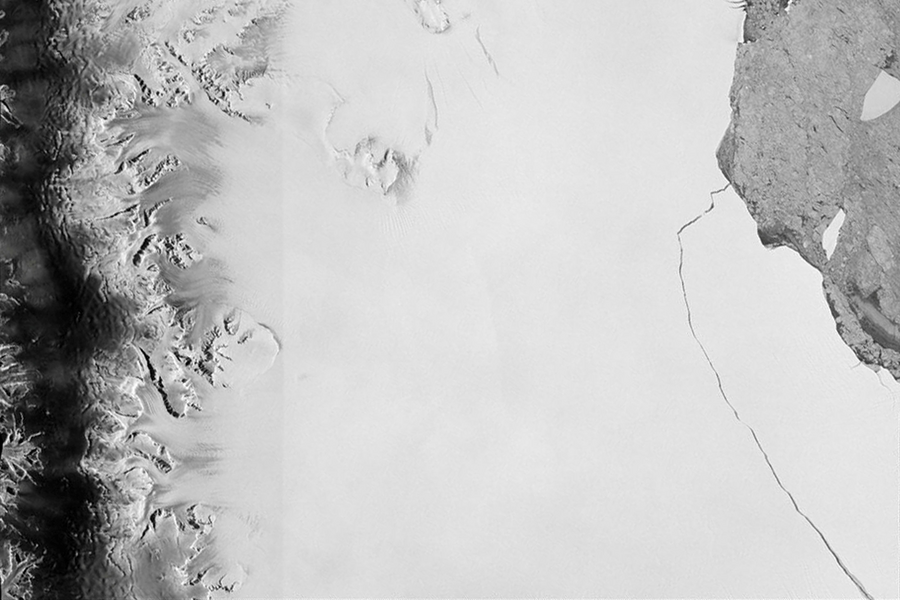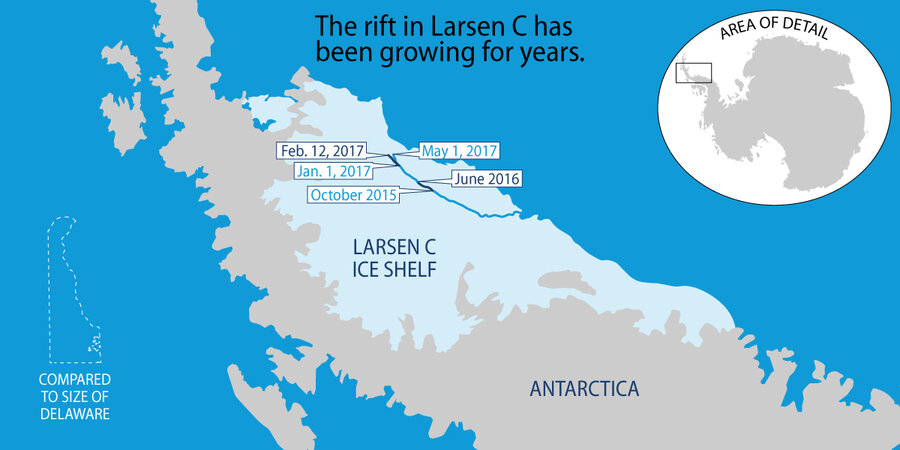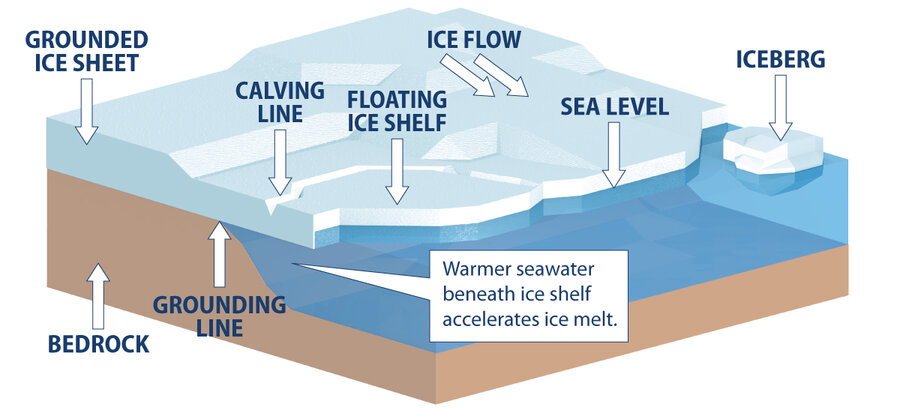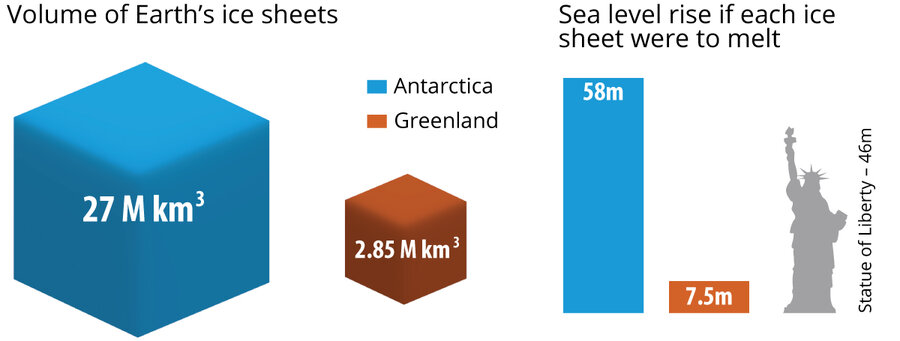Antarctica’s big break: What role for climate change?
Loading...
The term “calving” might seem to imply something small, but there’s nothing small about the iceberg that just broke off from the Larsen C Ice Shelf in Antarctica.
Roughly the size of the US state of Delaware, the newly formed iceberg weighs more than a trillion tons, and its volume is twice that of Lake Erie. It’s one of the largest ever recorded.
Scientists have been watching the growing rift in the Larsen C ice shelf for years now, though the exact moment that the calving finally occurred – sometime between Monday, July 10 and Wednesday, July 12 – is tricky to pinpoint.
What happened, and why does it matter?
A calving or break-off of this size is always an important event, and this one dramatically alters the landscape of the Antarctic Peninsula, leaving the huge Larsen C Ice Shelf the smallest it’s been since it was discovered in 1893.
On one level, a calving like this is a natural event, part of the constant growth and reduction of ice sheets. These huge floating ice masses extend out from glaciers on land. They grow as glaciers flow into them and from snow accumulation, and they shrink from calving as well as melting at their upper and lower surfaces.
The Larsen C Ice Shelf should continue to naturally regrow, but researchers at Swansea University in Wales, who lead the MIDAS Project following Larsen C, have said that the shelf may be less stable following the rift, and that there is potential for it to follow the same path of its neighbor, the Larsen B Ice Shelf, which had a major calving event in 1995 and then disintegrated in 2002.
“In the ensuing months and years, the ice shelf could either gradually regrow, or may suffer further calving events which may eventually lead to collapse – opinions in the scientific community are divided,” said Adrian Luckman of Swansea in a blog post Wednesday. “Our models say it will be less stable, but any future collapse remains years or decades away.”
Is climate change involved?
This is a matter of debate among scientists. Unlike some other major ice shelf rifts – including the calving and eventual disintegration of Larsen B – there’s not a clear role played by human-caused climate change.
The ice shelf had been thinning for several decades, due in part to warmer air, causing surface snow to melt, sink down into the thicker snow layer, and refreeze.
“It doesn’t seem like surface warming is causing the break,” says Ted Scambos, lead scientist at the National Snow and Ice Data Center (NSIDC).
But, he says, there was likely a small amount of thinning on the underside of the ice shelf – even though it’s in a cold-water system where temperatures are barely shifting – which could have made a critical difference.
“That few percent of ice-shelf thickness change may have been enough to make it weaker and allow it to crack in this new location we haven’t seen before,” says Dr. Scambos. “That would be a climate-change effect, though not a significant one, and nowhere near what we saw from Larsen A and B.”
Does this contribute to sea-level rise?
The short answer is no. The ice shelf was already floating, so its break doesn’t affect sea levels, in the same way that an ice cube in a glass wouldn’t change the water level even when it melts.
The big players in sea-level rise are the massive ice sheets (which sit on land) in Antarctica and Greenland, which together store 99 percent of the world’s freshwater ice. If those two ice sheets melted completely (not something anyone is suggesting is likely in the foreseeable future), sea levels would rise by about about 66 m (217 ft).
Indirectly, disintegration of ice shelves can contribute to sea level rise in that they provide a buffer between the ice sheets and the ocean; as they disappear, glacial flow into the ocean can increase.
In other areas of Antarctica, such as Pine Island Bay and other areas along the South Pacific coast – where no big ice shelves remain – those changes are more concerning, and more rapid, than at the Larsen Ice Shelf.
“The Larsen C is an example of where even in cold-water systems… you can eventually impact the stability of an ice shelf that looked like it was good to go for the next 30 or 40 years,” says Scambos. “The events on Larsen C might be telling us more about how large ice shelves elsewhere – like the Ross and Ronne – will evolve in the future.”
How does this play into the broader world of polar ice?
For the average person watching reports of decreasing Arctic sea ice, or retreating glaciers, or melting ice sheets, parsing the terms, and the changes, can be difficult.
Sea ice, for instance – the relatively ephemeral floating icebergs in both the Antarctic and Arctic that form when ocean water freezes – is much more significant in the Arctic, which lacks a continent at the pole, than in the Antarctic. That's one reason the rapidly shrinking sea ice cover in recent years has gotten so much attention.
In Antarctica, sea ice has actually been growing, but much of the research attention has been directed toward ice shelves like the Larsen C – which float in the sea, but are an extension of land ice – and the massive Antarctic Ice Sheet.
The effects of climate change on the Antarctic are much less clear than they are for the Arctic, but close satellite monitoring is helping scientists get a better handle on how changes are occurring.
With the Larsen C rift, scientists will be closely watching where the floating part goes, changes in speed, and whether any new cracks appear in the ice shelf that indicate continued instability, says Scambos. “If it really is the start of a retreat until we do see parts of the Larsen C Ice Shelf gone, maybe we can point to this event, and say it started then. Right now, there’s a better than even chance that the ice shelf will simply push back out again for at least a few years, back in the direction where the ice was lost.”











